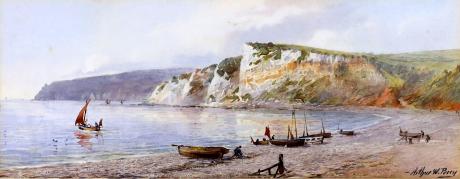signed "Arthur W Perry"
These cliffs reach over 400ft in height in some places and are made of Cretaceous limestone, popular with stonemasons for its workability. Seaton has been a popular holiday destination since Victorian times, with a further boost to the town’s tourist economy during the 1930s, when large-scale holiday camps were built to serve the growing demand for accommodation and entertainment along the English coastline. The first chain of such camps was launched by Harry Warner, who pioneered the concept and built one of his first camps in Seaton in 1935, with the assistance of a certain Billy Butlin, a funfair entrepreneur. Butlin so liked the holiday camp concept that he took the workers he’d employed in Seaton up to Skegness, where he built the first Butlins in 1936.
Seaton is a seaside town, fishing harbour and civil parish in East Devon on the south coast of England, between Axmouth (to the east) and Beer (to the west). It faces onto Lyme Bay and is on the Dorset and East Devon Coast Jurassic Coast World Heritage Site. A sea wall provides access to the mostly shingle beach stretching for about a mile, and a small harbour, located mainly in the Axmouth area.
A farming community existed here 4,000 years before the Romans arrived and there were Iron Age forts in the vicinity at Seaton Down, Hawkesdown Hill, Blackbury Camp and Berry Camp. During Roman times this was an important port although the town's Roman remains have been reburied to preserve them. In Saxon times Seaton was known as Fluta or Fleet, the Saxon word for creek. The town of Fleet was founded by Saxon Charter in 1005 AD. The first mention of Seaton was in a papal bull by Pope Eugenius in 1146.
Seaton was an important port for several centuries, supplying ships and sailors for Edward I's wars against Scotland and France. In the 14th century heavy storms caused a landslip which partially blocked the estuary, and the shingle bank started to build up. In 1868 the arrival of the railway reduced the use of the harbour.
In November 2013 builder Laurence Egerton, a metal detector enthusiast, unearthed the Seaton Down Hoard of copper-alloy coins. The hoard, of about 22,000 Roman coins, is believed to be one of the largest and best-preserved 4th-century collections ever found in Britain. A team of archaeologists carefully removed and cleaned the coins over the next 10 months.
Seaton was served by a branch rail line, opened in 1868, from Seaton Junction on the Salisbury to Exeter main line. The railway was successful and considerably assisted in the development of Seaton as a holiday destination. A Warners holiday camp opened in 1935 close to the station, encouraged by the ease of travel.
With the increase in car ownership in the 1960s, usage of the line declined, and with many other Devon branch lines, it closed in 1966. The nearest railway station now is at Axminster, seven miles away. Part of the trackbed was purchased in 1969 to construct Seaton Tramway, which opened in 1970 and links Seaton with Colyford and Colyton.
In the 19th century Seaton developed as a holiday resort, which it remains to this day. After much protest Seaton lost its largest holiday camp at the beginning of 2009[8] when the site was purchased by Tesco who opened a major supermarket on the site in late 2011. However, Seaton still has many accommodation providers including guest houses, hotels, a camping site and a caravan park.
The church on the edge of town was built in the 14th century, with a squat tower dating from the 15th century. Seaton is also notable for having one of the world's first concrete bridges, built over the River Axe in 1877, by the Seaton and Beer Railway company. This is one of the earliest concrete bridges in Britain.[7] Many of the town buildings are Victorian, including a notable collection of large houses at Seaton Hole, but the town also has notable buildings from the 1930s and later periods. Seaton Town Hall, now used as a theatre, was completed in 1904.
There are 3,300 homes in the parish, of which approximately one third are of single-person occupancy. The majority of those persons are of pensionable age. The area to the east of the retail area to the River Axe (mainly floodplain) has been the subject of a regeneration plan formulated in 2003 and approved in detail in 2009, despite local opposition. As of early 2011, the level of the site has been raised above flood level using a million tons of sand brought in by sea. A large Tesco supermarket and filling station have been built on one half of this site: the other half is to be offered for residential development. A Jurassic Coast Discovery Centre has also been erected nearby, being completed in 2016. A further residential development is planned along the riverside.
He lived & worked at Prospect House in Seaton, Devon. He painted in watercolour & specialised in landscape, coastal & village scenes. Many of his works were reproduced as hand coloured half tone postcards by Worth's Art Gallery in Exeter.
He didn't exhibit widely, but did exhibit two works at the Royal Birmingham Society of Artists in 1908.



